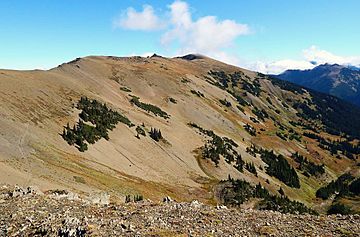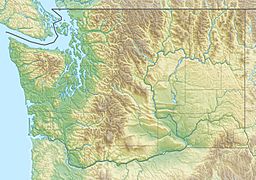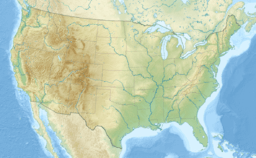Elk Mountain (Clallam County, Washington) facts for kids
Quick facts for kids Elk Mountain |
|
|---|---|

Elk Mountain seen from Obstruction Peak
|
|
| Highest point | |
| Elevation | 6,773 ft (2,064 m) |
| Prominence | 813 ft (248 m) |
| Geography | |
| Location | Olympic National Park Clallam County, Washington, United States |
| Parent range | Olympic Mountains |
| Topo map | USGS Maiden Peak |
| Geology | |
| Age of rock | Eocene |
| Type of rock | Shale |
| Climbing | |
| Easiest route | Hiking Trail |
Elk Mountain is a tall peak in the Olympic Mountains of Washington state. It stands at about 6,773 feet (2,064 m) high! You can find it inside Olympic National Park, right at the eastern end of a popular area called Hurricane Ridge. Even though it's called Elk Mountain, you won't find any elk living on its slopes today.
The closest taller mountain is McCartney Peak, about 5.12 mi (8.24 km) away to the south-southwest. Rain and melting snow from the mountain's south side flow into small streams that join the Dungeness River. Water from the north side flows into streams that feed Morse Creek, which then empties into the Strait of Juan de Fuca.
Olympic National Park is home to the largest wild herd of Roosevelt elk in the Pacific Northwest. These elk are named after President Theodore Roosevelt. They are the biggest type of elk in North America. It's interesting that no elk are found around Elk Mountain today, despite its name.
Contents
How Elk Mountain Got Its Name
The mountain's name comes from a story told in a 1984 field guide. In 1890, a local settler named William Wooding and his friends hunted many elk at this spot. They left the elk bodies to decay in the woods. When Wooding returned to town, he made the mistake of bragging about what they had done. The authorities quickly ordered him and his friends to go back to the site and carry out all the dead elk.
Weather and Climate at Elk Mountain
Elk Mountain is in the north-central part of the Olympic Mountains. This area has a marine west coast climate. This means it gets a lot of influence from the ocean.
How Weather Forms
Most weather systems start over the Pacific Ocean. They then travel northeast towards the Olympic Mountains. When these weather systems reach the mountains, the peaks force the air upwards. As the air rises, it cools and drops its moisture. This creates a lot of rain or snow, a process called Orographic lift.
Seasons in the Mountains
Because of this, the Olympic Mountains get a lot of rain and snow, especially in winter. During winter, it's usually cloudy. However, in summer, high-pressure systems over the Pacific Ocean often bring clear skies. The ocean's influence also means that the snow tends to be wet and heavy. This can sometimes lead to avalanche danger, so it's important to be careful.
The Rocks of Elk Mountain
The Olympic Mountains are made of special types of rock. These rocks were formed from material pushed up from the ocean floor. They are mostly Eocene sandstone, turbidite (rock formed from underwater landslides), and basalt (a type of volcanic rock).
How the Mountains Were Shaped
The mountains we see today were shaped over a long time during the Pleistocene era. This was a period when large glaciers grew and shrank many times. These glaciers, along with erosion from water and wind, carved out the valleys and peaks we see in the Olympic Mountains, including Elk Mountain.
Images for kids
-
North aspect of Elk Mountain in the distance as seen from Rocky Peak
-
Elk Mountain seen from Eagle Point






